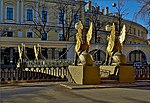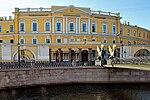Griboyedov Canal

The Griboyedov Canal or Kanal Griboyedova (Russian: кана́л Грибое́дова) is a canal in Saint Petersburg, constructed in 1739 along the existing Krivusha river. In 1764–90, the canal was deepened and the banks were reinforced and covered with granite. The Griboyedov Canal starts from the Moyka River near the Field of Mars. It flows into the Fontanka River. Its length is 5 kilometres (3 mi), with a width of 32 metres (105 ft). Before 1923, it was called the Catherine Canal, after the Empress Catherine the Great, during whose rule it was deepened. The Communist authorities renamed it after the Russian playwright and diplomat, Alexandr Griboyedov. The streets or embankments running along the canal are known as Naberezhnaya Kanala Griboyedova.
Excerpt from the Wikipedia article Griboyedov Canal (License: CC BY-SA 3.0, Authors, Images).Griboyedov Canal
Griboyedov Channel Embankment, Saint Petersburg Apraksin Dvor (округ № 78)
Geographical coordinates (GPS) Address Nearby Places Show on map
Geographical coordinates (GPS)
| Latitude | Longitude |
|---|---|
| N 59.9327 ° | E 30.3251 ° |
Address
Griboyedov Channel Embankment 25
191186 Saint Petersburg, Apraksin Dvor (округ № 78)
Saint Petersburg, Russia
Open on Google Maps











